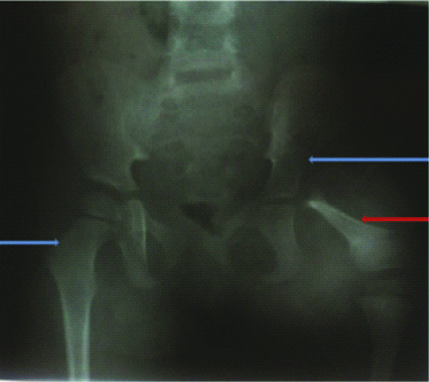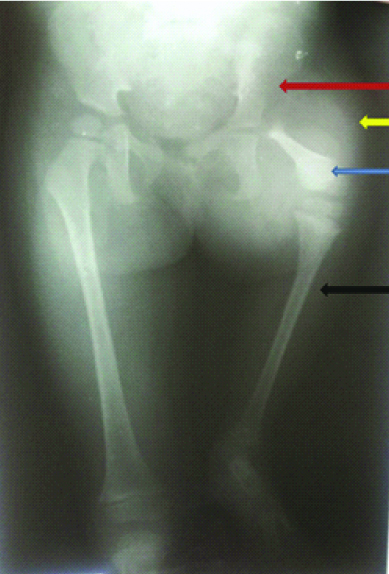Type II Proximal Focal Femoral Deficiency in a Three-Year-Old Female: A Case Report
Muhammad Baba Sule1, Ibrahim Haruna Gele2, Yakubu Bababa Shirama3, Muhammad Abacha4
1 MBBS, FWACS: Consultant, Department of Radiology, Usmanu Danfodiyo University, Sokoto, Nigeria.
2 Consultant, Department of Radiology, Usmanu Danfodiyo University Teaching Hospital, Sokoto, Nigeria.
3 Consultant, Department of Radiology, Abubakar Tafawabalewa Teaching Hospital, Bauchi, Nigeria.
4 Brad, Mrad, Radiographer, Lecturer 2, Department of Radiology, Usmanu Danfodiyo University, Sokoto, Nigeria.
NAME, ADDRESS, E-MAIL ID OF THE CORRESPONDING AUTHOR: Dr. Muhammad Baba Sule, Department of Radiology, Usmanu Danfodiyo University, Sokoto, Nigeria.
E-mail: muhammadsule@yahoo.com
Proximal Focal Femoral Deficiency (PFFD) is a term used to describe a condition where the femur is short and associated with an apparent loss of continuity between the shaft and neck. PFFD is reported as an uncommon but complex clinical condition. This was commonly grouped with other disorders like coxa vara and short bowel tumours. This has a female to male ratio of 2:1 and an incidence of 1 case per 50,000 population to 1 case per 200,000 population. This is a case report of a three-year-old female that was referred for plain radiograph of the lower limbs on account of limb-length discrepancy and abnormal gait. The plain pelvic and lower limb radiograph showed a markedly shortened femur with non-demonstration of the femoral head and neck. There was a vertically oriented acetabula fossa with altered acetabula and iliac angles. The patient is currently managed conservatively mainly by reassurance and use of crutches.
Congenital, Discrepancy, Femur, Limb-length
Case Report
A three-year-old female was referred from a peripheral health care centre for a plain radiograph of the pelvis and lower limbs on account of limb-length discrepancy and abnormal gait. No history of similar occurrence in the siblings or family relations was reported. The mother denied any history of drug abuse or maternal illness during pregnancy. She had an uneventful pregnancy and delivery. On physical examination, the female child appeared well nourished in stable condition without any form of distress. There was limb-length discrepancy with a shortened left thigh and marked left thigh skin fold thickness. The cardiovascular examination was normal. The plain pelvic and lower limb radiographs showed a markedly shortened femur with non-demonstration of the femoral head and neck [Table/Fig-1,2]. Vertically oriented acetabula fossa with altered acetabula and iliac angles were noted [Table/Fig-1]. There was absence of left fibula though the left knee and ankle joints appeared within normal limits [Table/Fig-2]. Abdominopelvic ultrasound scan showed normal abdominal organs and situs. The index case was managed conservatively in the peripheral health care system by reassurance and use of crutches and was planned for referral to a tertiary institution for possible surgical (amputation) and expert management. The patient did not undergo and also failed to attend any follow-up visits; all efforts to get across to the patient for further monitoring have failed.
A plain antero-posterior radiograph of the pelvis and part of the lower limbs. This shows a shortened and dysplastic left femur (red arrow). The left acetabulum is vertically oriented with a shallow acetabula groove and abnormal acetabula and iliac angles (blue left arrow). The right side appeared normal (blue right arrow).

A plain antero-posterior radiograph of the lower limbs showing left limb-length discrepancy, prominent left thigh soft tissue shadow (yellow arrow), shallow and vertically oriented left acetabula fossa (red arrow); dysplastic and shortened left femur (blue arrow) and absent left fibula (black arrow); showing only the left tibia without left fibula consistent with type II PFFD.

Discussion
The term PFFD is used to describe a condition where the femur is short and associated with an apparent loss of continuity between the shaft and neck [1]. This case presented with a rather short left femur. PFFD is reported in the literature as a rare congenital anomaly presenting with stoppage of usual growth of the proximal femur and hip joint [2]. This was the first case in the family with no similar occurences in her lineage and presented with a short abnormally developed left femur and left pelvic bone. PFFD is a rare but multifaceted congenital skeletal anomaly which may be associated with other osseous defects [3]. The index case presented with associated absent left fibula hence agreeing to literature. In PFFD, the proximal segment of the femur is affected but a portion of the femur is always present in order to differentiate PFFD from complete femoral agenesis [3]. The index case also had remnants of the femur though fore-shortened. PFFD is commonly grouped with other disorders like Coxa Vara and Short bowel tumours [2]. This has a female to male ratio of 2:1 and an incidence of one case per 50,000 population ranging from one case per 200,000 population [4,5]. This is a case of a female patient, hence similar to that documented in the literature.
The aetiology of PFFD is not known but lots of theories have been postulated [4,6,7]. PFFD is a non-hereditary birth anomaly that affects the pelvis mostly, especially the hip joint and proximal femur of one or both sides [8]. The aetiology is not known in the index case, which presented with vertical orientation of the left pelvis, acetabula, and iliac angles, respectively. PFFD has been classified into four classes ranging from class A to D as described by Aitken GT and Hatch D [8,9]. The limb-length discrepancy in these patients is difficult to treat and is often unmanageable except by amputation [10,11]. The index case belonged to Aitken class A because of the presence of a femoral head and acetabulum; this class of patients can be managed by options other than amputations [5,6], the case was managed conservatively by reassurance and use of appropriate crutches and not by amputation of the affected limb. Mental disorders and chromosomal abnormalities are not often associated with patients of PFFD [12]. The patient had a stable mental status oriented to time, place and person, hence agreeing to the literature. However, there was no facility of karyotyping to rule out chromosomal abnormalities. Prenatal diagnosis of PFFD has been documented by some authors [13-15], but, there was no opportunity of having the prenatal history or ultrasound reports of this patient. The index case was diagnosed in the postnatal period following a plain pelvic and lower limb radiograph at the age of three years. PFFD is more commonly detected and seen affecting the right femur and may be in isolation without other osseous anomalies [16]. However, this index case had left femur and acetabula affected in association with absence of left fibula. PFFD is one of the causes of leg length discrepancy; it’s often associated with some congenital bony anomalies, most commonly ipsilateral absent or hypoplastic fibula [17]. This index case also presented with left leg-length shortening with absent left fibula agreeing to the literature, with no other osseous abnormalities.
Conclusion(s)
PFFD is a relatively uncommon skeletal anomaly whose aetiology is largely unknown but can be diagnosed on plain radiograph. Limb prosthesis, adequate conservative management and reassurance can improve the individual’s quality of life.
Author Declaration:
Financial or Other Competing Interests: None
Was informed consent obtained from the subjects involved in the study? Yes
For any images presented appropriate consent has been obtained from the subjects. Yes
Plagiarism Checking Methods: [Jain H et al.]
Plagiarism X-checker: Nov 21, 2019
Manual Googling: Jan 06, 2020
iThenticate Software: Sep 22, 2020 (4%)
[1]. Olgun ZD, Liu RW, The pediatric orthopedic society of North AmericaProximal focal femoral deficiency. [Internet]Available from: www.posna.org/proximal focal femoral deficiency (accessed on 19th November 2019) [Google Scholar]
[2]. Wesberry DE, Davids JR, Proximal Focal Femoral Deficiency (PFFD): Management options and controversiesHip Int 2009 6:S18-25.10.1177/112070000901906s0519306244 [Google Scholar] [CrossRef] [PubMed]
[3]. Graviss ER, Monteleone PA, Wampler LR, Silberstein MJ, Broduer AE, Proximal femoral focal deficiency associated with the Robin anomaladJ Med Genet 1980 17:390-92.10.1136/jmg.17.5.3907218279 [Google Scholar] [CrossRef] [PubMed]
[4]. Agarwal AK, Proximal focal femoral deficiency. [internet] Jaffe WL, Talavera F, Bal BS, editors. Medscape. WebMD LLC; c1994-2020[Updated Nov 26, 2018; Accessed 19th November 2019]. Avalable from: emedicine.medscape.com. 2012 [Google Scholar]
[5]. Ifesanya AO, Omolulu BA, Proximal focal femoral deficiency in Ibadan a developing country’s perspective and review of the literatureNig J Paed 2011 38(2):95-99.10.4314/njp.v38i2.72258 [Google Scholar] [CrossRef]
[6]. Ahmadu MS, Farate A, Farouk AG, Bilateral proximal femoral focal deficiency in a neonate; A case reportBorno Medical Journal 2018 15(1):107-11.10.31173/bomj.bomj_95_15 [Google Scholar] [CrossRef]
[7]. Boden SD, Fallen MD, Davidson R, Mennati MT, Kaplan FS, Proximal femoral focal deficiency. Evidence for a defect in proliferation and maturation of chondrocytesJ Bone Joint Surg Am 1989 71(8):1119-29.10.2106/00004623-198971080-000012777837 [Google Scholar] [CrossRef] [PubMed]
[8]. Aitken GT, Proximal Femoral Focal Deficiency: Definition, classification and management. In: Aitken GT, editorProximal Femoral Focal Deficiency: A congenital anomaly 1969 Washington DC, USANational Academy of Sciences:5010.1093/ptj/50.8.1284 [Google Scholar] [CrossRef]
[9]. Hatch D, Proximal femoral focal deficiency. [Internet]Orthobullets c2020 Lineage Medical, Inc[Updated Updated: 4 March 2017, Accessed 19th November 2019]. Available from: www.orthobullets.com/proximal-femoral-focal-deficiency [Google Scholar]
[10]. Koman LA, Meyer LC, Warrant FH, Proximal femoral focal deficiency: Natural history and treatmentClin Orthop Relat Res 1982 165:135-43.10.1097/00003086-198201000-00023 [Google Scholar] [CrossRef]
[11]. Mike M, Proximal femoral focal deficiency: A parent’s guide. [internet][Accessed 19 November 2019]. Available from: myplace.frontier. com/pffdvsg1/req-pffdguide.htm [Google Scholar]
[12]. Doger E, Kopuk SY, Cakıroglu Y, Cakır O, Yucesoy G, Unilateral isolated proximal femoral focal defiencyCas Rep Obstet Gynecol 2013 2013:63790410.1155/2013/63790423984135 [Google Scholar] [CrossRef] [PubMed]
[13]. Mailath-Pokomy M, Timor-Tritsch E, Monteaqudo A, Mittal K, Konno F, Santos R, Prenatal diagnosis of unilateral proximal femoral focal deficiency at 19 weeks gestation: A case report and review of literatureUltrasound Obstet Gynecol 2011 38:594-97.10.1002/uog.899521438051 [Google Scholar] [CrossRef] [PubMed]
[14]. Lin TH, Chung CH, Shin JC, Lin CH, Su YN, Prenatal diagnosis of proximal femoral focal deficiency: A case report and literature reviewTaiwan J Obstet Gynecol 2013 52:267-69.10.1016/j.tjog.2013.04.02023915863 [Google Scholar] [CrossRef] [PubMed]
[15]. D’Ambrosio V, Pasquali G, Squarcella A, Marcoccia E, De Filippis A, Gatto S, Prenatal diagnosis of proximal focal femoral deficiency: Literature review of prenatal sonographic findingsJ Clin Ultrasound 2016 44:25210.1002/jcu.2230626408260 [Google Scholar] [CrossRef] [PubMed]
[16]. Zainab B, Proximal femoral focal deficiency in a newbornAnn Saudi Med 2004 24:482-83.10.5144/0256-4947.2004.48215646171 [Google Scholar] [CrossRef] [PubMed]
[17]. Schatz SL, Kopits SE, Proximal femoral focal deficiencyAm J Roent 1978 131:289-95.10.2214/ajr.131.2.28998010 [Google Scholar] [CrossRef] [PubMed]